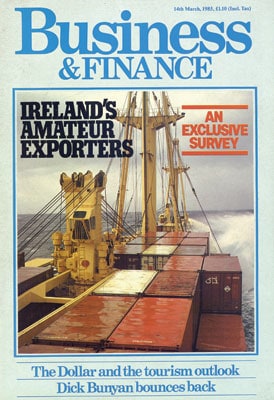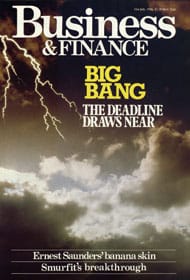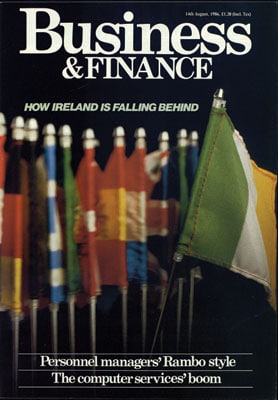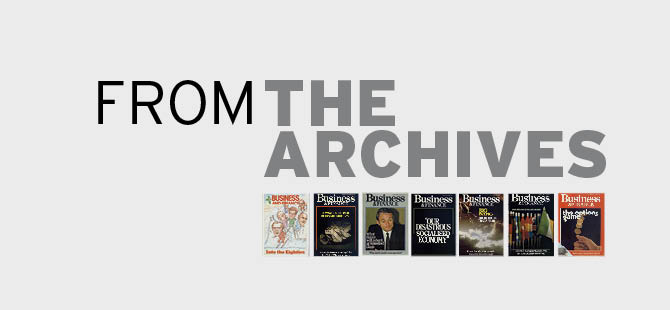This week, as part of our celebration of 50 years of Business & Finance, we look at the headline making news stories of the 1980s. A decade of economic depression, new technology, the fall of the Berlin Wall and questionable fashion.
The 1980s
 Mounting unemployment
Mounting unemployment
Throughout the 1980s and early 1990s unemployment mounted inexorably. It only reached 100,000 in 1980, but had topped 200,000 by 1984.
The primary culprit was demographics. There were not enough jobs for the baby boomers of the 1960s and 1970s. In addition, the number of people retiring was abnormally low due to the extremely high emigration of the 1940s and 1950s.
Paddy Gallagher – a deal too far (1982)
In the late 1970s and early 1980s, property developer Paddy Gallagher could do no wrong. Every site he touched seemed to turn to gold. Indeed, in the frenetic property market of the time he had often offloaded a site before he had paid for it.
To help him fund his activities he had his own financial institutions, Merchant Banking and the O’Connell Benefit Building Society. When the inevitable crash came in 1983 there were debts of over £10m. While no action was taken against him in the Republic, he was jailed in Northern Ireland in connection with the Merchant Banking Affair.
PMPA – Joe Moore bites the dust (1983)
In October 1993, commerce minister Frank Cluskey rushed an emergency Insurance Act through the Dáil and Senate in just one day. It provided for a 2% levy on all insurance premiums.
The following day Kevin Kelly, then of Coopers & Lybrand, was appointed administrator of PMPA. It emerged that the company had been systematically underproviding against losses. By the end of 1982 the estimated underprovisions had risen to £100m.
As the legislation was going through the Oireachtas, company founder Joe Moore sold one million PMPA shares to its PMPS deposit-taking subsidiary for £400,000. The cheque was not cleared by the bank.
 Irish Shipping sinks (1984)
Irish Shipping sinks (1984)
In 1984, Irish Shipping became the first state-owned company to go bust when Maurice Tempany was appointed liquidator. The company, which had reported 15 consecutive years of profit, lost £12.6m in 1983. In 1984, losses were expected to reach £26m, which would have wiped out reserves leaving the company bankrupt.
The root of the problem was a number of charter contracts which Irish Shipping entered into with a number of Hong Kong shipowners in the early 1980s. Unlike the standard shipping charter contracts, these did not have a cancellation clause in the event of freight rates falling. This puzzled shipping experts.
On September 13th 1984, accountant Frank Belton was appointed chairman of Irish Shipping. The situation was so bad that within a month he recommended the appointment of a liquidator.
The ICI collapse (1985)
New AIB boss Gerry Scanlon was hardly a wet day in the job when he was faced with a crisis which nearly dragged the bank under. Its recently acquired ICI insurance subsidiary, which it had acquired from Irish Shipping, was hopelessly insolvent. The major cause of the problem was ICI’s London office. Business & Finance had predicted the collapse several months previously.
The Central Bank, anxious to preserve confidence in the banking system, organised a £165m rescue package which saw Craig Gardner’s Billy McCann appointed administrator. This made ICI the second Irish insurance company to go bust.
 Waterford Crystal crashes (1987)
Waterford Crystal crashes (1987)
In 1987, less than a year after it had acquired china manufacturer Wedgwood, Waterford Wedgwood shocked the market with the news that it would have to implement a major redundancy programme at its Waterford and Dungarvan plants. This cost the company £50m, but did not solve the problems of the company’s escalating costs and the collapsing dollar.
It was still not out of the woods. In 1989, it was revealed that the company had been overvaluing its stock. This was followed by a three-month strike in 1990. The company was only saved when Morgan Stanley/Fitzwilton took a 29.9% stake in the company in 1990. The year before, Paddy Galvin was brought in from Guinness to run the crystal operation.
Gradually they nursed the company back to health, though the company had to threaten closure in late 1992 to get its rationalisation programme accepted by the workforce.
 The Single European Act (1987)
The Single European Act (1987)
In 1987 the member countries of the EEC passed the Single European Act. This provided for the creation of a single European market by 1992. Frontiers would be removed and VAT and excise duties would be harmonised.
Perhaps more importantly from an Irish point of view, we received over £3bn of structural funds.
In this country the Single European Act was enlivened by the late Raymond Crotty’s constitutional challenge.
This was partly successful and the Supreme Court ordered the holding of a referendum which approved the Single European Act.
Next Friday we will be we powering on through to Ireland in the 1990s.
*To read this article in its entirety, pick up a copy of the 50th Anniversary edition of Business & Finance, available now.





